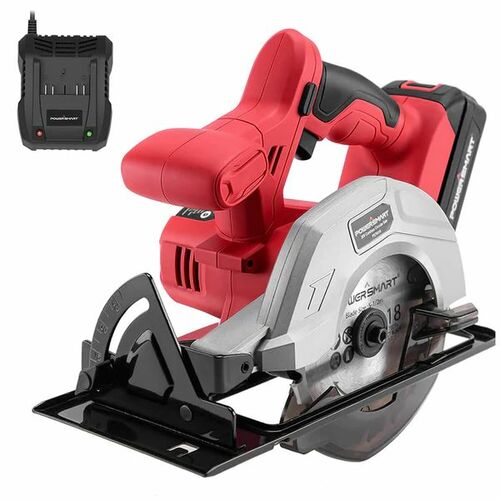How to Safely Use a Circular Saw: A Beginner’s Guide
Introduction
If you’ve got a list of DIY projects you’re eager to tackle, chances are a circular saw is on your must-have tool list. This versatile power tool can make quick work of tasks like cutting shelves, trimming boards, and even building furniture. But let’s be real: while a circular saw can be your best DIY buddy, it’s also powerful enough to demand your full respect. Safety and confidence are the keys to getting great results!
This guide will walk you through how to safely use a circular saw, from setting up a solid workspace to understanding different saw features and mastering your cuts. Whether you’re a first-time homeowner or a DIY enthusiast diving into power tools for the first time, let’s make sure you’re equipped to handle a circular saw like a pro—safely and confidently.
What’s a Circular Saw and Why Should You Care About Safety?
Circular saws are the workhorses of the DIY world. With a fast-spinning circular blade, these saws slice through wood, metal, and even plastic, making them ideal for everything from quick fixes to full-on home renovation projects . But because they’re powerful, they can also be dangerous if not handled correctly.
In this guide, we’re covering the essentials: what to look for in a beginner-friendly circular saw, key safety gear, and step-by-step tips for making smooth, controlled cuts.
Ready to dive in? Here’s what you need to know to operate a circular saw with confidence and control.
Get Ready: Setting Up Your Workspace and Gear
Before you even turn on the saw, let’s talk about prepping your workspace and making sure you’re protected. With just a little setup, you’ll create a safer, more enjoyable experience.
1. Choose Your Workspace Wisely
- Stable Surface: Working on a wobbly table? That’s a no-go! Set up on a solid workbench or use sturdy sawhorses. Stability is key.
- Good Lighting: Make sure you can clearly see where you’re cutting. Dim spaces can make it harder to see your lines and can lead to mistakes.
- Keep it Clear: Remove any extra tools or materials in your workspace. Clear floors, too, so you don’t trip mid-project.
2. Don’t Forget Your Safety Gear
This might sound obvious, but safety gear is your friend. When using a circular saw, always have:
- Safety Glasses : Protect your eyes from flying debris—an absolute must.
- Ear Protection : Circular saws can be loud, so earplugs or earmuffs are helpful to prevent long-term hearing damage.
- Dust Mask : Inhaling sawdust? Not great. A dust mask keeps your lungs happy.
- Heavy-Duty Gloves : For a strong grip and added hand protection.
Understanding Circular Saws: Corded vs. Cordless
When it comes to circular saws, you have two main choices: corded or cordless. Each has its own perks, so let’s look at which one might suit your projects best.
- Corded Circular Saws: If you’re planning longer projects that need consistent power, a corded saw is your best bet. Just plug it in, and you’re ready to go for as long as you need.
- Cordless Circular Saws: Prefer a bit of freedom? Cordless saws run on batteries, which is great for quick tasks and outdoor projects. Just keep an eye on battery life.
Top Beginner-Friendly Circular Saws: Recommendations for Every Budget
1. Budget-Friendly Options

An Efficient and Portable Cordless Circular Saw for DIY Enthusiasts
Price: $79.99
Description: Lightweight and portable, this PowerSmart saw offers a 5.5-inch blade with adjustable depth, allowing for cuts up to 1.6 inches at 90 degrees. With a comfortable grip and safety switch, it’s excellent for smaller tasks and for beginners looking for safety and ease of use.

Versatile WORX Handheld Circular Saw for Precision DIY Cutting
Price: $69.99
Description: The WORX WORXSAW is a small yet powerful circular saw designed for one-handed operation, which is helpful for beginners needing control and precision. It’s suitable for cutting through wood, metal, and plastic and offers a bevel angle adjustment of up to 45 degrees. With a compact and lightweight build, it’s ideal for smaller, precise DIY tasks.
Pros: Affordable, easy to handle, and ideal for small projects or light use. These saws are designed with ergonomic handles and safety features, making them suitable for those just starting out.
If you’re just starting out, look for beginner-friendly models with features like an electric brake (stops the blade fast) and a blade guard for added protection. These will give you a little extra security as you get familiar with the tool.
2. Mid-Range Choices for Frequent DIYers

Price: $199.99
Description: This tool combines a powerful brushless motor with enhanced battery efficiency, providing reliable power for demanding home projects. Its 7.25-inch blade size allows for more precise cuts across different materials, from wood to metal, making it ideal for versatile DIY applications.
Pros: Powerful, versatile, and durable. With a brushless motor and a 7.25-inch blade, this saw offers efficient cordless flexibility and is ideal for larger DIY projects. Its ergonomic design, precision parallel guide, and lightweight build make it easy to handle, even for intermediate users.
If you’re just starting out, look for beginner-friendly models with features like an electric brake (stops the blade quickly) and a blade guard for added protection. These will give you a little extra security as you get familiar with the tool.
Step-by-Step Guide to Safe Circular Saw Operation
1. Position Yourself and the Saw Properly
- Good Stance: Stand to the side of your cutting line with one foot slightly in front of the other. This keeps you balanced and out of the way if the saw jumps.
- Grip It Right: Keep both hands on the saw for control, with one hand on the handle and the other on the pommel. A steady grip helps you guide the saw accurately.
2. Starting the Saw
- Reach Full Speed First: Let the saw reach full speed before bringing it to the material. This minimizes any jerking or “sticking” at the start.
- Follow Your Line: Move slowly and let the saw do the work. Pushing too hard can make the saw strain and increases the risk of kickback.
3. Avoiding Kickback
Kickback is one of the most common (and potentially dangerous) issues with circular saws. Here’s how to prevent it:
- Use a Sharp Blade: Dull blades can catch or “grab” the wood, increasing the chance of kickback.
- Choose the Right Blade for the Material: Using a wood blade on metal or vice versa can be a recipe for trouble.
- Keep Hands Clear of the Blade Path: Always keep your hands and fingers out of the blade’s path—this sounds obvious, but it’s worth a reminder!
Maintenance and Care: Keep Your Circular Saw in Top Shape

Homeowner Maintains Circular Saw for Safe, Efficient Use
A well-maintained saw will last longer, perform better, and—most importantly—stay safer.
Daily Maintenance Tips
- Clean Up After Each Use: Wipe down the saw and clear out sawdust or particles that could interfere with moving parts.
- Blade Wipe-Down: Keeping the blade clean prevents buildup that could impact performance.
Long-Term Care
- Store in a Dry Place: Humidity can rust metal, so keep your saw in a dry, dust-free area.
- Battery Care: If you have a cordless saw, remember that batteries don’t like extreme temps. Store them in a temperate area for the longest life.
Level Up: Tips and Techniques for Getting More from Your Circular Saw
Want to get even more versatility from your saw? Try these tips and accessories to expand its functionality.
Using Guide Rails for Perfectly Straight Cuts
If you’re aiming for precise lines, guide rails are a game-changer. They attach to the saw to help you glide in a perfectly straight line, which is especially useful for long cuts on plywood or larger boards.
Adding Dust Collection for Cleaner Cuts
If you’re working indoors, consider adding a dust collection attachment. This handy add-on can help keep your space clean and reduce airborne dust—a bonus for your lungs and your workspace.
Experimenting with Different Cut Types
- Straight Cuts: Essential for most DIY work, from shelves to panels.
- Angled Cuts (Bevel Cuts): Great for decorative finishes and joining pieces at angles.
- Plunge Cuts: Use these to cut openings in the middle of a material, such as cutting out a window or an inlay.
Common Questions and Safety Reminders
How Often Should You Replace the Saw Blade?
If you notice the saw slowing down or burning the wood, it’s time for a new blade. Regularly inspect the blade for dullness or chips.
Can You Use a Circular Saw Indoors?
Yes, but make sure you have good ventilation and wear a dust mask. Sawing indoors can get messy, so try a dust collector or work near an open window.
What Materials Can You Cut with a Circular Saw?
With the right blade, circular saws can cut through wood, metal, plastic, and masonry. Just make sure to use a blade suited to each material.
Wrapping Up: Get Ready to Tackle Your DIY Projects with Confidence
A circular saw is an incredible tool for DIYers, and with these safety tips and techniques, you’re now ready to use it like a pro. Remember, practice makes perfect—take it slow, follow the steps, and prioritize safety at every stage. When used correctly, a circular saw opens up endless possibilities for creative and practical projects around the house.
Ready to get started? Check out our top picks for essential home power tools and unlock the full potential of your DIY projects today!
We may receive affiliate compensation for some of the links below at no cost to you if you decide to make a purchase.


